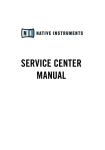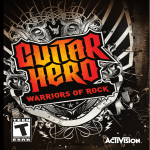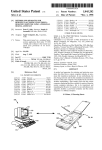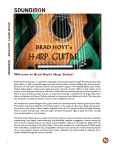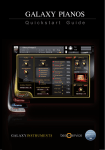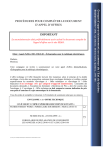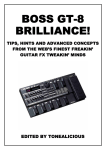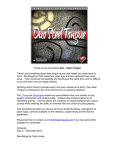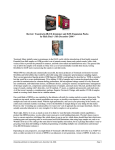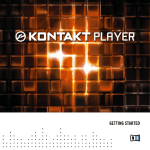Download ASSAULT Manual
Transcript
Welcome to ASSAULT™ by Sample Logic™ Thank you for purchasing ASSAULT powered by KONTAKT PLAYER. This manual is designed to guide you through the features available in ASSAULT. The information in this document is subject to change without notice and does not represent a commitment on the part of Native Instruments Software Synthesis GmbH. The software described by this document is subject to a License Agreement and may not be copied to other media. No part of this publication may be copied, reproduced or otherwise transmitted or recorded, for any purpose, without prior written permission by Native Instruments Software Synthesis GmbH. All product and company names are trademarks of their respective owners. User Manual written by Sample Logic, LLC ASSAULT©2013 All Rights Reserved. Sample Logic, LLC Sample Logic™ and ASSAULT™ are trademarks of Sample Logic, LLC. Sample Logic, LLC New York www.samplelogic.com [email protected] © Native Instruments Software Synthesis GmbH, 2013. All rights reserved. KONTAKT is a trademark of Native Instruments Software Synthesis. Germany Native Instruments GmbH Schlesische Str. 28 D-‐10997 Berlin, Germany www.native-‐instruments.de USA Native Instruments USA, Inc. 5631 A Hollywood Boulevard Los Angeles, CA 90028 www.native-‐instruments.com ASSAULT 1 Table of Contents MISSION STATEMENT ................................................................................................................... 3 END USER LICENSE AGREEMENT .................................................................................................. 3 INTRODUCTION ............................................................................................................................ 4 What is ASSAULT ........................................................................................................................... 4 TECHNICAL SPECIFICATIONS ........................................................................................................ 5 ASSAULT IN DEPTH ....................................................................................................................... 6 How ASSAULT is organized ............................................................................................................ 6 Instrument Categories .................................................................................................................. 6 User Interface & Controls ............................................................................................................. 7 General Feature Overview & Descriptions .................................................................................... 8 Triggers ......................................................................................................................................... 25 Arpeggigater .................................................................................................................................. 26 LFO Seq Module ............................................................................................................................ 27 Multi Script Macros ....................................................................................................................... 28 TIPS & TRICKS ............................................................................................................................... 29 TROUBLESHOOTING ..................................................................................................................... 29 CREDITS ......................................................................................................................................... 30 ***For Installation Instructions, please see the “Quickstart Installation.pdf” ASSAULT 2 MISSION STATEMENT Sample Logic’s mission is to design new cutting edge tools for composers, producers, sound designers, musicians and performers of all musical styles and genres. This is why we are continually developing new concepts for sample libraries that ™ focus on blurring the line between music and sound design. As a company, we continue to move forward, building a bridge to the future by exploring unique undiscovered sonic territory, while providing more tools for the composer’s toolbox. END USER LICENSE AGREEMENT All of the sounds offered in our products are created and owned by Sample Logic LLC. By purchasing a copy of our products the original owner is granted a lifetime license of 2 machine authorizations to freely use the enclosed sounds for any commercial purposes provided the following conditions are met: (1) The License forbids resale, relicensing, or other distribution of these sound samples and software, either as they exist on each disc, Internet server, or any modification thereof. The original owner cannot assign, lease, lend, rent, resell, upload or download to or from any database or server, or transfer any or all of the sound samples and software to another user, or use them in any competitive or retail product. (2) Sample Logic LLC is not held responsible if the material sold does not fit the end users initial purpose. The sounds and samples are sold “as is” with no warranty or refund privileges, unless the product is proven defective. If the product is defective the end user is permitted 30 days after the time of purchase to contact Sample Logic with his or her claim and will receive further instructions where to return the defective product. No money will be refunded, however a new copy of the product will be sent to replace any defective products. (3) Licensor does not take responsibility for sold material that does not properly translate to sample instrument formats that were not originally programmed in and offered. To purchase additional licenses contact [email protected]. ASSAULT 3 INTRODUCTION WHAT IS ASSAULT? ASSAULT is a massive suite of over 850 bone-‐crushing instruments and multis that transform sound design into superior cinematic percussive instruments. In creating ASSAULT, Sample Logic teamed up with veteran broadcast sound design and sound effect mastermind Rick Allen to record a monumental collection of real world sound material ranging from rifles, flame throwers, hand guns, jets, dumpsters, and monstrous pipes to bells, chimes, glass, and an arsenal of traditional percussive instruments. From this material, we spent numerous hours carefully manipulating and morphing the sounds to forge a sample library that will no doubt be your secret weapon. ASSAULT is geared for film, TV, game composers and sound designers. HOW IT'S ORGANIZED ASSAULT is intuitively organized and divided into a variety of unique categories such as: explosive impacts, rises & falls, interrupters, reverses, sweeps, scrapes, quick kits, tempo-‐synced arpeggiated rhythms and a collection of over 85 customized Multis that are deeply programmed that will send chills down your spine. UNPRECEDENTED INTERFACE CONTROLS ASSAULT hosts a collection of unprecedented interface controls providing over 40 unique sections of onscreen effects and parameters. The interface is built upon Sample Logic's renowned "multi-‐core effect sequencer", providing the ability to assign effects via tempo-‐synced step sequencers and LFOs to any instrument parameter, including the option to sequence the bypass function of each effect in real-‐time. TRIGGERS ASSAULT also contains “Triggers” that provides 48 unique effect chains that can be triggered by any one or combination of the six on-‐screen keypads, or by key-‐switches. With the touch of a pad or key, Triggers can be instantly activated or bypassed, allowing for complete on-‐the-‐fly performance control with the ability to drastically effect the sound of any instrument instantly and non-‐destructively. MULTIS & MULTI SCRIPT MACROS One of the biggest features introduced in ASSAULT are the powerful "Multi Script Macros", first introduced in Cinematic Guitars 2. Now more lethal than ever, Multi Script Macros can be automated by using the new macro knob step sequencers, resulting in real-‐time macro sequencing and instrument parameter control. On top of that, each of the 6 Macro knobs can be assigned to any combination of instrument parameters within a multi. Multi script macros are completely customizable and can be easily created and saved, simply add or subtract them by using the plus and minus buttons on the multi interface. By design, any combination of instrument interface parameters can be assigned to a single macro. Whether performing live or automating a multi in a DAW, Multi Script Macros are the perfect production solution. For those of you who prefer to simply pull out the big guns, ASSALUT comes with over 85 customized Multis that are already locked and loaded. ASSAULT 4 WHAT’S UNDER THE HOOD? • Over 850 Instruments and Multis recorded and processed at 48k/24-‐bit, delivered at 44.1k/24-‐bit. • Just under 1 GB sample library using Kontakt’s lossless sample storage compression • NI Kontakt 5 Player with native 64-‐bit support • Stand-‐alone, VST, AU, DXi, RTAS (Pro Tools 9 or higher), ASIO, CoreAudio, WASAPI INSTRUMENTS • Bone-‐crushing Impacts • Cinematic Rises and Falls • Dynamic Interrupters • Percussive Arpeggigated/Arpeggiated/Gated Instruments (sequenced) • Breathtaking Swipes, Scrapes, and Reverse Transitional Effects MULTIS • 66 score-‐ready multis • Performance-‐ready multis with up to 6 customizable Multi Script Macros • Each Multi Script Macro has its own customizable step sequencer for Macro automation TECHNICAL SPECIFICATIONS • • • • • Kontakt 5 Player 5.0.3 or higher (free download) or full version of Kontakt 5.0.3 or higher (sold separately) Mac OS X 10.6, 10. Or 10.8 (latest update), Intel Core Duo, 2 GB RAM (4GB recommended) Windows 7 (latest Service Pack, 32/64 Bit), Intel Core Duo or AMD Athlon 64 X2, 2GB RAM (4GB recommended) 1 GB free disk space for Kontakt 5 Player 1 GB free disk space for ASSAULT sample content ASSAULT 5 ASSAULT IN DEPTH Important features that will enhance your experience with ASSAULT. • Most instruments feature a variety of key ranges and transpositions that are pitched relative to the chromatic scale. • In most cases, samples have been mapped so their fundamental pitches are nearest to the middle C octave range (C3). Sample ranges outside the recommended key map should be used at your own discretion. • Sample key ranges have been stretched (transposed) to maximize creative possibilities and sonic fidelity. How ASSAULT is organized ASSAULT is built around 8 main categories: Each category is named by a general sound type or intended use. Within each folder are instruments that are named by their by genre, timbre, and the mood they evoke, but by no means should they be limited by their title or category. Our system is designed to better help you with organization and finding the sound you are looking for. Please keep in mind that Instruments are named based on what our programmers felt appropriate. Some could fit into multiple categories; therefore they are named in a way that suggests this. In these situations, the instruments are placed into the genre that it most appropriately fits. Instrument Categories INSTRUMENTS Arpeggiated – Customizable tempo-‐synced sequenced impact loops. Combos – A combination of sound elements that sustain and morph over time. Impacts Interrupters – Short non-‐tempo synced transitions effects for bridging tempo/key variant music transitions. Reverses Rises – Falls Scrapes Sweeps Quick Kits – Instruments containing large collections samples from one genre. MULTIS – Powerful preset templates combining various ASSAULT instruments into all-‐in-‐one presets. Construction Beds – Various instruments types mapped out across the keymap in zones. Instrument Stacks – Several instruments stacked on top of one another, sharing the same keymap range. Definitions: Instruments labeled MW means that they are pre-‐programmed with effects assigned to the Mod Wheel. Instruments labeled SEQ means that they are pre-‐programmed with tempo-‐synced effects driven by the internal Multi-‐core Effect Sequencers inside the instrument interface. Instruments labeled ARG means that they are pre-‐programmed with effects assigned to the Arpeggigater. Instruments labeled TRG means that they are pre-‐programmed with effects assigned to the Triggers. ASSAULT 6 User Interface & Controls There are three main types of Instrument Interfaces. Each instrument consists of multiple windows and a static mixer control section: MIXER VIEW – Default MIXER VIEW – Wave View ASSAULT 7 GENERAL FEATURE OVERVIEW & DESCRIPTIONS F C A E B G D A – Effect ON/OFF – Red = ON, Black = Off B – Sequencer ON/OFF buttons – When activated, use the corresponding knob to control the strength of the effect. Green = Active, Black = Off. These buttons are located next to any parameter that can be sequenced. C – Random – When clicked, all of the effect parameters are randomized. The intensity can be scaled in Options (G). D – Strength Meter – Displayed for selected sequenced effect parameter. Green is low and Red is strong. E – Open Controls – Click “+” to open the corresponding controls window. F – Parameter Display Box – Displays the currently selected effect parameter and value. G – Options – Access to the instrument’s performance parameters. ASSAULT 8 EQ Presets – Choose an EQ preset from the dropdown menu. Each Freq. band can be sequenced by clicking on the black button to the left of the fader. Freq – Frequency band. Gain – The boost or attenuation at the selected frequency band. Note: When an EQ parameter is assigned to a sequencer, its knob controls the strength of the parameter being sequenced. ASSAULT 9 COMPRESSOR Presets – Choose a Compressor preset from the dropdown menu. Threshold – Sets a level above which the compressor starts reducing peaks. Signals above the threshold are effected, those below are uneffected. Ratio – Determines the amount of compression. Attack – Sets how quickly the compressor kicks in after input signal exceeds the threshold. Release – Sets how quickly the compressor stops when the input signal falls below the threshold. Output – Sets the output level of the overall processed effect. Note: When a compressor parameter is assigned to a sequencer, its knob controls the strength of the parameter being sequenced. ASSAULT 10 FILTER Presets – Choose a Filter preset from the dropdown menu. Lo-‐Cut / Hi-‐Cut – Use the Cutoff knobs to set the frequency at which low/high frequencies signals are cut (attenuated) Note: Hi-‐Cut is assignable to MIDI input velocity under the Options window. Reson – Use the Resonance knob to create a boost at the Hi-‐Cut cutoff frequency. Note: When a filter parameter is assigned to a sequencer, its knob controls the strength of the parameter being sequenced. ASSAULT 11 LoFi Presets – Choose a LoFi preset from the dropdown menu. Bit – Determines the resolution in bits. Lower values cause a stronger lo-‐fi effect S Rate – Sample Rate Reduces the high frequency response and overall signal quality. Noise – Adds hiss to the audio signal. Color – Noise Color Determines the tonality of the noise applied to a signal. Increase to dampen high freq. noise. Output – Sets the output level of the overall processed effect. Note: When a LoFi parameter is assigned to a sequencer, its knob controls the strength of the parameter being sequenced. ASSAULT 12 DISTORTION Presets – Choose a Distortion preset from the dropdown menu. Tone – Sets the brightness of the process signal. Drive – Determines the “crunch factor”. The amount of distortion. Bright – Controls the tone of the high frequencies. Bass – Controls the tone of the low frequencies Output – Sets the output level of the overall processed effect. Note: When a Distortion parameter is assigned to a sequencer, its knob controls the strength of the parameter being sequenced. ASSAULT 13 ROTATOR Presets – Choose a Rotator preset from the dropdown menu. Speed – Sets the speed of the rotating speaker (slow or fast). Balance – Sets the ratio of sound produce between the rotating speaker’s high frequency horn compared to the low frequency woofer. Distance – Sets the distance between the virtual microphones and the rotating speaker. Mix – Controls the effect’s strength. Note: When a Rotator parameter is assigned to a sequencer, its knob controls the strength of the parameter being sequenced. ASSAULT 14 PHASER Presets – Choose a Phaser preset from the dropdown menu. Depth – Determines the amount of the LFO modulation. Higher values make effect stronger. Speed – Sets the speed of the LFO modulating the signal. Phase – Effects the phase difference between the LFOs that drive the left and right stereo channels. Feedback – Controls the intensity of the effect. Note: When a Phaser parameter is assigned to a sequencer, its knob controls the strength of the parameter being sequenced. ASSAULT 15 FLANGER Presets – Choose a Flanger preset from the dropdown menu. Depth – Determines the amount of the LFO modulation. Speed – Sets the speed of the LFO modulating the signal. Phase – Effects the phase difference between the LFOs that drive the left and right stereo channels. Color – Sets the speed of the LFO modulating the signal. Feedback – Sets the speed of the LFO modulating the signal. Note: When a Flanger parameter is assigned to a sequencer, its knob controls the strength of the parameter being sequenced. ASSAULT 16 CHORUS Presets – Choose a Chorus preset from the dropdown menu. Depth – Sets the amount of LFO modulation applied to a signal. Higher amounts result in stronger chorusing. Speed – Sets the speed of the LFO modulating the signal. Phase – Effects the phase difference between the LFOs that drive the left and right stereo channels. Note: When a Chorus parameter is assigned to a sequencer, its knob controls the strength of the parameter being sequenced. ASSAULT 17 DELAY Presets – Choose a Delay preset from the dropdown menu. Time – Sets the time resolution of the delay based on rhythmic values. Damping – Reduces high frequencies in the delayed signals. Pan – Sets a panning effect where consecutive repeats/echoes alternate between left and right channel. Feedback – Sets the amount/presence of repeating echoes. Dry/Wet – Sets how much delay is applied to the mix relative to the original signal. Note: When a Delay parameter is assigned to a sequencer, its knob controls the strength of the parameter being sequenced. ASSAULT 18 REVERB (Convolution or Digital) Type – Switches between convolution and digital reverb. Presets – Choose a Reverb preset from the dropdown menu or toggle left & right. Size – Changes the length of the impulse sample. Lowpass – Attenuates frequencies above the chosen cutoff frequency. Highpass – Attenuates frequencies below the chosen cutoff frequency. Pre Delay – Determines the room size by setting the length of the effect. Reverse – Reverses the playback direction of the IR. Size – Changes room size. Color – Determines the type of material used to construct the room. Damping – Sets the amount of absorption in the room. Higher values = more absorption. Stereo – Adjusts the width of the reverb’s spatial image. Pre Delay – Adds a short amount of delay before the effect takes place. ASSAULT 19 ARP/ART Arp/Art Toggle – Choose between the Arpeggiator and Articulator engine. ARP uses velocity (0-‐100) to determine playback volume. ART adds and subtracts velocity values from the MIDI input velocity by +/-‐ 100 (0 = no effect). Note Order/Gate – Select note order/direction from various presets for the ARP. This is where the GATER is activated. Octave – Add octave transpositions to the ARP step range. Strike – Sets the number of repeats per note. Duration – Alters the note length of each ARP step. Presets – Choose from 10 preset patterns. Steps Window – Determine the playback pattern of the ARP/ART. Steps are governed by velocity. Draw in custom rhythms with the mouse pointer by clicking and dragging in the step window. Speed – Adjust the tempo in rhythmical values, synced to the master tempo. Steps – Set the number of steps from the input field to right of the steps window (type or drag/click). Sus. Pedal Control (Articulator Only) – When activated, the sustain pedal controls when the Articulator is engaged. When the sustain pedal is pressed, the ART runs, when depressed, the ART is off. Fixed Velocity – Sets the initial input velocity played to the max input value. Copy / Paste – Copy or Paste a pattern, steps, and speed. Random – Randomize the pattern, steps, and speed. Humanizer – Adds random velocity variations to the ARP/ART based on the offset assigned. ASSAULT 20 CABINET Presets – Choose a Cabinet preset from the dropdown menu and a Amp type. Size – Adjusts the size of the simulated cabinet. Air – Controls the level of early reflections in the room response, adding a sense of space to the sound. Treble – Boosts or cuts the level of high frequencies. Bass – Boosts or cuts the level of low frequencies. Output – Sets the output level of the overall processed effect. Note: When a Cabinet parameter is assigned to a sequencer, its knob controls the strength of the parameter being sequenced. ASSAULT 21 OPTIONS Glide – Sets the glide time between notes creating sliding effect between consecutively played notes. Voices – Sets the number of voices played when pressing a key. Spread – Controls the panning amount of each voice. Detune – Sets the detuning between voices. Pitch Bend Semitones – Sets the number of semitones that the pitch bend wheel controls. Velocity Intensity – Controls how much influence the velocity input has over volume. Random Intensity – Controls how drastic the master randomize button in the Mixer section effects the overall instrument. Monophonic – Enables monophonic (1 voice) playing mode. Velocity to Hi-‐Cut – Assigns MIDI input velocity to effect the Hi-‐Cut filter. ASSAULT 22 PAN Pan Sequencer ON/OFF – Activates pan sequencing for the chosen mic. Pan Slider – Controls pan of the chosen mic. Step/LFO Toggle – Choose between the sequencer and LFO for parameter automation. ASSAULT 23 VOLUME Volume Knob – Controls the gain of the overall instrument. Volume Sequencer ON/OFF – Activates volume sequencing for the whole instrument. Note: When volume is assigned to a sequencer, its knob controls the strength of the volume being sequenced. Step/LFO Toggle – (when seq. is activated) Choose between the sequencer and LFO for volume automation. ASSAULT 24 TRIGGERS (TRG) Triggers ON/OFF – Activates the entire TRG module ON or OFF. Presets – Choose a Trigger effect preset from the dropdown menu. Orange Trigger Pads – Click an orange Trigger pads to activate an effects chain. Add up to 6 effects chains simultaneously. Low/Hi – Sets the key map position of the Trigger key switches to highest or lowest keyboard octave. Red = KS area. KeySwitch Hold – When activated, key switches remain depressed automatically until pressed again. Note: When a Trigger effect chain is activated the Trigger effect jump button will glow orange. ASSAULT 25 ARPEGGIGATER (ARG) Arpeggigater ON/OFF – Activates effect bypass sequencing for any effect module that is ON and assigned to the ARG. Effect Chooser – Choose between 14 effects and 6 Trigger effect chains to arpeggigate. The step sequencer in view corresponds to the effect listed in the chooser. Effect Buttons – Click on an effect button to select the effect to arpeggigate. Each button has an icon for its effect module. The second row of buttons are for the Triggers. Effect Sequencer ON/OFF – When on, the associated effect’s bypass sequencer will be active. Note: The Arpeggigater and the Effect Module must be ON for the effect bypass sequencer to take effect. Presets – Choose from 10 preset patterns. Steps Window – Determines the playback pattern of the Arpeggigater (full bar = ON, no bar = Bypassed). Draw in custom patterns with the mouse pointer by clicking and dragging in the steps window. Speed – Adjust the tempo in rhythmical values, synced to the master tempo. Steps – Set the number of steps from the input field to right of the steps window (type or drag/click). Copy / Paste – Copy or Paste a pattern, steps, and speed. Random – Randomize the pattern and steps. ASSAULT 26 LFO SEQ Module Parameter Chooser – Select the effect to edit. Strength Meter – Displays the strength of the sequenced effect parameter. Speed – Determines the speed of the LFO. Fade In – Adds a attack envelope to the LFO. Waveform Chooser – Choose the type of LFO: Sine, Square, Triangle, Random LFO Preset Chooser – There are 3 LFOs presets that can be assigned. Retrigger – When activated, the LFO is triggered with MIDI input. When deactivated, it runs continuously. ASSAULT 27 MULTIS – Multi Script Macros Each multi has its own set of up to 6 macro controls that are assignable to external MIDI control and Kontakt MIDI CC control. The title of each macro can be customized by double-‐clicking or highlighting the name and typing in a new name. To reassign or assign new parameters to the macros, right-‐click on the desired parameter in an instrument to “learn MIDI” and then click on a macro to assign it. Each Multi Script Macro has its own customizable step sequencer for Macro automation. An active sequencer will automate the assigned knob using the step pattern in the steps window. +/-‐ Buttons – Add or subtract Macro knobs. Macro knobs – Each macro knob is scalable using the number boxes to the left and right of each knob. Ext Chooser – Assigns an external controller CC# to the macro knob. CC Chooser – Assigns macro knob to control the selected CC#. Presets – Choose from 10 preset patterns. Steps Window – Determines the playback pattern of the sequencer (0-‐127). Draw in custom patterns with the mouse pointer by clicking and dragging in the steps window. Speed – Adjust the tempo in rhythmical values, synced to the master tempo. Steps – Set the number of steps from the input field to right of the steps window (type or drag/click). Copy / Paste – Copy or Paste a pattern, steps, and speed. Random – Randomize the pattern, speed and steps. ASSAULT 28 TIPS & TRICKS • • • • • ASSAULT can be loaded into the full retail Kontakt 5.0.3 or higher, which is a separate application not included, but may be purchased from Native Instruments. This provides you the ability to customize the internal sample programming and effects. If you own Kontakt 5, you can load this library and experiment, stretch, layer, alter loop lengths, and apply effects to each instrument. Slight alterations in instrument programming may improve sample playback for your software and desired effect. Customized instruments should be saved with a new unique name so the originals are preserved. There are many sonic possibilities buried deep within ASSAULT waiting to be discovered, but if you are just starting out or in a hurry, we suggest trying out the Multis (multi-‐instrument presets) for a true taste of ASSAULT. We recommend that you explore the library. Be sure to audition every key and sample. Save large templates of instruments as Multis to expedite your workflow. When sequencing effects in the user interface, try adjusting the “Strength” knob(s) to moderate maximum effect ranges, especially when effects cause resonant peaks or pops in the audio. Consider reducing the release time for instruments that are sequenced when you desire to play melodic or fast changing musical lines. A shorter release will allow sequenced effects to retrigger from the start of their pattern; otherwise they will latch onto the sequencers current location. TROUBLESHOOTING If something doesn't seem to work correctly, there must be a logical reason for it. Native Instruments software is tested on a variety of computers and configurations to ensure proper function. Having said that, there remain an infinite number of possible setups and within them any number of compatibility issues, software conflicts, hardware problems, and so on. Performance issues -‐ If your CPU becomes bogged down during playback causing audio popping, glitches, or dropouts, try the following suggestions: • • • • Try turning off any convolution reverbs that are ON. Reduce the number of voices in each instrument on the instrument interface. Purge unused samples for instruments. • • Adjust the latency slider under Audio settings tab from Kontakt’s Options menu. Set the Kontakt CPU overload protection to “relaxed” or “medium” etc., and/or set the appropriate multiprocessor settings from the Engine settings tab under Kontakt’s Options menu. If you have more than 2GB of RAM, experiment with the KMS – Kontakt Memory Server settings from the Memory tab under Kontakt’s Options menu. For unresolved issues, including authorization and installation troubleshooting, visit support page at www.samplelogic.com/support , or send us an e-‐mail at: [email protected] ASSAULT 29 Credits Producers & Programmers Sample Logic, LLC Joe Trupiano & Keith Robinson Recordings Rick Allen Special Thanks Klaus Baetz The Native Instruments Team Ryo Ishido Steve Ouimette www.samplelogic.com ASSAULT 30






























